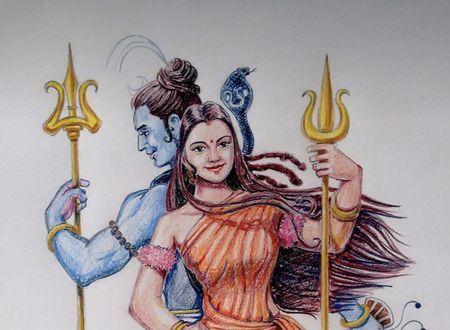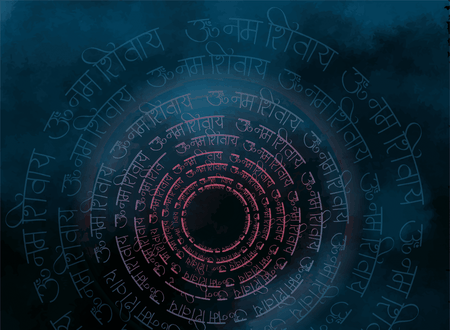You can read the previous part here: Part 2
*****
We step into the small village that Master Subarashi had told me about. Mount Fuji looms over us, the ash scattered across it reminding us of its deadliness. The village has some ashen areas as well, but nothing seems terribly ruined. In fact, it seems quite peaceful.
Houses are all around us, with little areas of ash in between some. These houses are small, but they still manage to look elegant and beautiful. Cherry blossom trees bloom near the houses, some blossoming fully and some not quite there yet. Every so often, we see peach trees blossoming as well, with succulent peaches hanging off the branches.
“Perhaps we should ask somebody about the pagoda,” Master Subarashi suggests. I nod in agreement.
I see a local woman and ask her, “We have come in search of the fabled pagoda. Do you know where it is?”
“No,” she says. “That’s a story told to kids by their grandparents. The grandparents were told the story by their grandparents. Nobody really thinks it exists.”
“But where is it located in the story?” I press.
“You’d better ask the priest in the temple over that way,” she says. “He’ll help you out.”
“Thank you,” I say, and we head off in that direction.
The temple is a Shinto temple, marked by the red torii gate in front. The gate is a typical design for Shinto temples, having two pillars sticking out of it on either side. We walk through the gate.
A shrine looks upon a lake. The building is not unlike many of the houses. Perhaps it’s more brightly colored. A priest sits quietly by the lakeside. He looks at the rippling water peacefully, and we look at the sight as well, in a trance for a few moments.
Finally, I break the silence. “Excuse me?”
The priest turns. “Yes?”
“We were told you had knowledge of the pagoda in this region,” I tell him.
“Ah, yes, the ancient pagoda by Mount Fuji,” he says. “Yes, I do remember that pagoda. It is quite dilapidated by now.”
“I see,” I say. “So, how do we get there?”
“I don’t remember the path exactly,” he says, “but I believe it is that way.”
He points his finger in a direction. “So we just head straight that way?” I ask him
“Yes,” he says. “You will find an old pagoda, perhaps ruined.”
“Thank you for your help,” I say, but I am quite worried. As we leave the shrine, I ask Master Subarashi, “What do we do? The pagoda is ruined!”
“Patience, Tengoku,” Master says. “Perhaps it will not be a problem. I am sure that there is a way for us.”
We walk toward the pagoda. As we walk, he starts giving me some of his wisdom.
“Patience is a virtue that is needed but rarely found. I remember an incident that happened about forty years ago. There was a man who was very hardworking. He toiled and toiled for years before getting a big house. He kept toiling, trying to get his daughter into the best school possible.
His daughter had some amazing qualities. She was really a wonderful person. At the young age of sixteen, she had achieved five of the Six Perfections. The only one that was lacking was patience. She was capable of meditating for hours at a stretch but was rarely patient enough to do so. She wanted mastery of all of the Six Perfections but didn’t have the patience to develop patience,” Master Subarashi pauses.
“The patience to develop patience?” I ask
“Yes,” Master Subarashi says. “Or perhaps I should say, the perseverance to develop patience. After all, perseverance is just a form of patience. The patience to know that you will not achieve anything major in a day will give you the perseverance to try again.”
“I see,” I say.
“The girl was very upset by the fact that she had not mastered the Six Perfections. Her classmates would often call her ‘The Impatient Donkey’, forgetting just how good of a person she really was.
After one particularly nasty day, she ran to a mountain and cried. She cried to the Bodhisattva Guanyin. Guanyin was stricken with pity after hearing the girl’s cries and appeared in front of her. Guanyin did whatever she could to make the girl feel better and then spoke to her about patience.
Guanyin said ‘Everybody has patience and perseverance. It is up to you to nurture it. Sit in meditation on this spot for an hour a day. Do this for a year. After that, you will have achieved mastery over the Six Perfections, and I will ensure that you become a bodhisattva’.
After saying this, she disappeared. The girl took Guanyin’s advice to heart and meditated on that spot for an hour every day. Often, she would stay there for triple that time, contemplating and sometimes crying. But she would meditate there, every day for a year.
Finally, Guanyin appeared in front of her. The bodhisattva asked, ‘Do you feel more patient now?’
The girl slowly nodded her head and got up. She bowed to Guanyin. She did everything quite slowly.
Guanyin laughed and said, ‘Being patient means being slow inside, not on the outside. Your body being slow will cause harm to you and others.’
After saying so, she made the girl a bodhisattva and took her to the realm of the bodhisattvas,” Master Subarashi says.
“I see,” I say.
“But do you, Tengoku?” Master asks. “You display several qualities of that girl. You are not very patient yet. Try to observe the world around you more. Contemplate. Eventually, you will become patient.”
“I will do so, Master,” I say. We walk silently for a while, still searching for the pagoda. Now, I observe the greenery around me. The view is so beautiful that I’m surprised that I hadn’t seen it earlier. I thank Master Subarashi for helping me see this magnificent sight.
*****
You can read the next part here: Part 4









Comments & Discussion
29 COMMENTS
Please login to read members' comments and participate in the discussion.